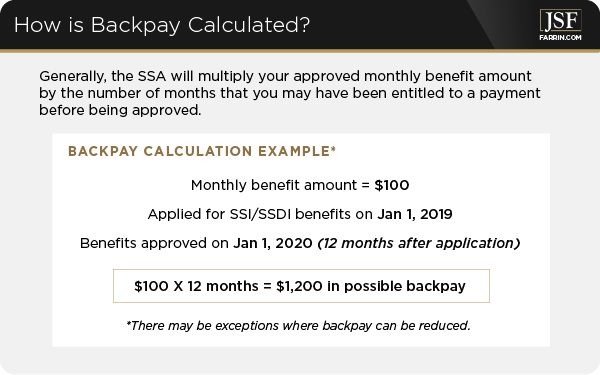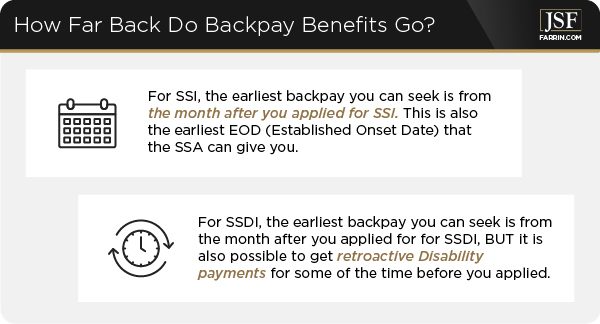When applying for disability, it is important to know not only what the Social Security Administration (SSA) is looking for while deciding on a disability claim, but also what benefits you’ll receive if it is approved. If you have done your research or spoken with someone that has received disability, you have probably heard of the term “backpay,” but you might not know what it is exactly, or how you receive it.
Social Security Disability Backpay, Defined
In short, Social Security Disability backpay is a lump sum payment for the time period that you were eligible to receive disability payments but were waiting to be approved for disability benefits. Because it can take people years to get approved for disability benefits, many people receive backpay and some people can receive a significant amount.
Once you are approved for Disability benefits, the SSA will then determine the following for backpay:
-
- When exactly you became disabled
-
- When you were entitled to start receiving payment
-
- How much your monthly benefit payment will be going forward, and
-
- How much backpay or retroactive disability benefits you are owed
Generally, your backpay amount is a calculation of your monthly benefit amount and how many months you were entitled to a payment before you were approved for benefits. There are many exceptions where backpay can be reduced.
However, generally speaking, the SSA will multiply the monthly benefit amount by the number of months that you were entitled to a payment before being approved and then will pay that total amount as one lump sum once you’re approved.
Before applying, it is important to know that your monthly benefit amount and how much backpay you may receive will be dependent on which disability program you apply under and the onset date of your disability, as determined by SSA.
For Social Security Disability Insurance (SSDI) Disability and Supplemental Security Income (SSI) Disability applicants, the SSA may grant backpay benefits back to the month after you applied for disability. SSA issues a backpay payment to compensate you for the time that you were disabled and eligible for payment but had to go through the SSA’s application process to get approved. It is important to note that although it is possible to receive backpay for the time that your claim was being processed, receiving backpay is not guaranteed. Additionally, if backpay is granted, the duration of time for which you will receive backpay and the amount of backpay are determined by the SSA.
SSDI and SSI Application Process: When Backpay Starts
When you submit your application for disability, you will tell the SSA that date that you believe you became disabled. This is called your Alleged Onset Date (AOD). After the SSA reviews your claim and finds you to be disabled, they will give you an Established Onset Date (EOD). The EOD is the day that the SSA has determined that you became disabled.
For SSI applicants, the earliest possible EOD that SSA will give is the day that you applied for SSI. This is why SSI backpay does not go back farther than the month after you applied for SSI.
For SSDI applicants, your EOD can be much earlier than the date of the application. For SSDI applicants with an earlier EOD, it is possible to get retroactive disability payments.
Disability Backpay vs. Retroactive Disability Payments
It is important to avoid confusing disability backpay and retroactive disability payments.
For SSDI applicants, it is possible to receive backpay for the period that you were waiting to get approved and retroactive disability payments for some of the time that you were disabled before you applied.
Retroactive disability benefits are paid for the time period after your EOD, after your entitlement date, but before you applied for SSDI. Retroactive disability benefits can be paid for up to twelve months (one year) prior to the submission of the SSDI application. To determine the amount of retroactive disability benefits, the SSA will set the EOD and the date of entitlement.
The date of entitlement is the date that someone approved under SSDI became entitled to monthly disability payments. This date is different from the EOD because under the SSDI payment rules, there is a mandatory five-month waiting period after the EOD before someone disabled under SSDI can start getting payments.
Whether you’re receiving backpay only or backpay and retroactive disability benefits, once the amount of benefits are calculated, you will receive the lump sum payment within two months of being approved for disability benefits.
Contact a North Carolina Social Security Disability Lawyer
Remember, backpay is not guaranteed and you can be approved for disability payments going forward without receiving an award for backpay or retroactive disability benefits. You should contact an attorney if you would like to know if you can receive backpay or retroactive disability benefits before you apply for SSI or SSDI. Please call our legal team at 1-866-900-7078 or contact us here if you have any questions.
You May Also Be Interested In
I’ve Worked All My Life. Why Aren’t I Eligible for Social Security Disability Benefits?
Social Security Disability Work Credits: What They Are and How They Work
Social Security Disability Attorney Rick Fleming Answers Client Concerns






